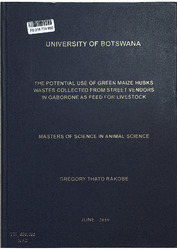| dc.description.abstract | Large quantity of Green maize husks (GMH) materials are thrown away by Street Vendors who sell roasted maize to tire public in Gaborone city. These wastes materials are causing nuisance as they attract animals and rodents and pollute the environment while they could be used as animal feed. A project, designed to evaluate the potential use of these GMH wastes as livestock feed was carried out by means of two studies. The wastes material was collected from street vendors around Gaborone City. In the first study, the chemical composition and the potential nutritive value using gas production and in vitro dry matter digestibility as an indicator of the potential value of GMH-based diets were carried out in the laboratory. The diets were as follows; 100 % dry maize husks (DMH), 100 % Green maize husks (GMH) and graded levels of Green maize husks as, 53% Green maize husks (GMH1), 65 % Green maize husks (GMH2) and 72% Green maize husks (GMH3). In the second study, the nutritional value of the GMH-formulated diets was tested in the feeding trial which lasted for sixty days, where weight gain and body condition scores of growing sheep were measured. Results from this study showed that there were significant differences (P>0.05) in the major chemical components except for acid detergent lignin (ADL) for both plain diets and total mixed ration diets. No significant differences (P>0.05) were detected in DMH and GMH on the rate constant (c), the time between inoculation and commencement of gas (Lag), Effective Degradability with outflow rate of 0.05/h (ED1) and Effective Degradability with outflow rate of 0.03/h (ED2). However, diets GMH1 and GMH2 had higher (P<0.05) Asymptotic gas volume (b) than diet GMH3 while diet GMH1 and GMH2 had lower in vitro dry matter digestibility (IVDMD) as compared to GMI-I3. The high content of crude protein in GMH1, GMH2 and GMH3 (11.45 to 14.45 %) and IVDMD for the same diets GMH, GMH1, GMH2 and GMH3 (61.82 to 77.33%) suggests that this feed resource can be used for feeding growing animals. For the second study, the final weight gained and body condition score were also significantly different (P<0.05). The selected diets from the first study produced similar (P>0.05) weight gain and a body condition score compared to the commercial diet. The implications of these observations seem to suggest that the Green maize husks are a potential source of nutrients for livestock. This study has shown that Green maize husks have good nutrition which, when incorporated with other protein feed ingredients, constitute a complete diet for growing ruminants. If farmers around the city can access this wastes material it could serve two purposes, namely one; to provide their livestock with feed and two, at the same time keep the environment clean by collecting it from the sale points. | en_US |

